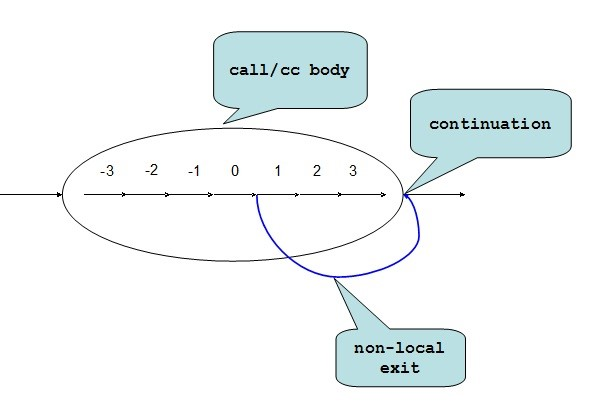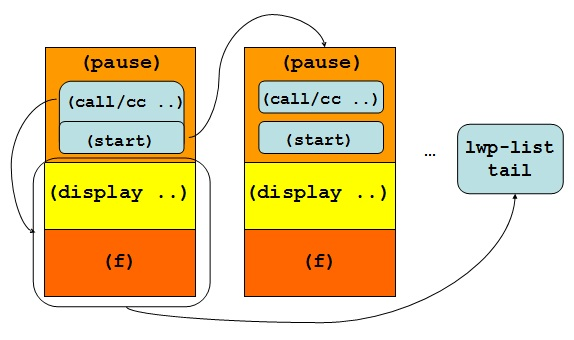理解 Continuation
终于,我也不能免俗地要来谈谈这几个 Schemer 的必谈话题(顺便山寨了一个标题)。
Scheme 是一门神奇的编程语言,它不仅是世界上第一个完整支持闭包(closure)的语言,也是世界上第一个提供 continuation 的语言。你可以看到 wiki 上几个关于 Continuation 的条目全部用 Scheme 作为示例语言。如无特指,本文以及接下来的两篇文章中凡是提到 continuation 的地方,均是指 Scheme 中的 continuation。
什么是 continuation ,它的语义其实不难理解,The Scheme Programming Language 说得很明白:
During the evaluation of a Scheme expression, the implementation must keep track of two things: (1) what to evaluate and (2) what to do with the value. ... We call "what to do with the value" the continuation of a computation.
Continuation 就是一个表达式被求值之后,接下来要做的事情。描述很简单,但是 Scheme continuation 的用法比较奇葩,导致我在学习 continuation 的过程中被几个问题困扰了很久,不过没关系,哥现在终于搞清楚了。写下这篇文章不是为了说明 continuation 是什么,而是想能帮助其他人更好地理解这个东西。下面我们通过几个小实验全面了解 continuation 的各个特性,在看每一个例子的时候,希望你先思考一下“这段代码的结果是什么?”、或者“为什么是这个结果?”,然后再看我的解说。
温馨提示:接下来的内容可能会让你的大脑感到不适,建议先阅读这篇文章。
#lang racket
;;; 定义一个过程
;;; 这是一个接受函数作为参数的函数,结果返回 3
(define (f c)
(c 2)
3)
;;; 似乎无论接受什么函数,结果都只能返回 3
(f (lambda x x)) ; 3
#|
----------------------------------
call/cc 接受一个函数,该函数接受一个参数,此参数即为 current-continuation
相当于(f current-continuation)
按 Applicative-order 展开
(define (f c)
(c 2)
3)
相当于过程 ((current-continuation 2) 3)
当调用后继时,call/cc 完成,返回值为后继接收到的参数。
程序返回到 (call/cc f)
current-continuation 接收到的参数是 2
(call/cc f) 执行完成返回 2
(call/cc f)
(f current-continuation)
((current-continuation 2) 3)
----------------------------------
|#
(call/cc f) ; 2
;;; 当前 xx 等于 #f
(define cc #f)
(display cc) ; #f
(newline) ; ~%
#|
-----------------------------------
call/cc 接受一个函数,该函数接受一个参数,此参数即为 current-continuation
我们将 (* 2 3) 的 current-continuation (用(+ ? (+ 1 7))表示) 绑定给 cc 变量
现在 cc 就对应了一个 continuation ,它相当于过程 (define (cc x) (+ (x) (+ 1 7))),等待一个值然后进行后续的运算
(+ (call/cc f) (+ 1 7)
(+ (f current-continuation) (+ 1 7))
(+ ((set! cc current-continuation) (* 2 3)) (+ 1 7)) ; 14
continuation === (define (cc x) (+ (x) (+ 1 7)))
-----------------------------------
|#
(+ (call/cc (lambda (return)
(set! cc return)
(* 2 3) ))
(+ 1 7)) ; 14
cc ; #<continuation>
(cc 10) ; 18
(cc (* 5 6)) ; 38
I. 非本地退出
Non-local exit,翻译成中文即“非本地退出”。非本地退出是初学 continuation 很好的例子,因为它逻辑简单,并且体现了 continuation 的三个特性,:
- continuation as first-class,简单地说就是 continuation 也可以视为一等公民,可以当做参数被传递和返回;
- continuation is represented by procedure,也就是说可以视 continuation 为过程,可以调用它,本来也应该如此,因为 continuation 表示的正是“将来要做的事情;
- 假设
call/cc捕捉了当前的 continuation,并绑定到 lambda 的参数 cc,那么在 lambda 函数体内,一旦 cc 被直接或间接的作为过程调用,那么call/cc会立即返回,并且提供给 cc 的参数即为call/cc的返回值。
请看下面这段程序:
#lang racket
(define (test element cc)
(if (zero? element)
(cc 'found-zero) ; non-local exit
(void)))
(define (search-zero test lst)
(call/cc
(lambda (return)
(for-each (lambda (element)
(test element return)
(printf "~a~%" element))
lst)
#f)))
(search-zero test '(-3 -2 -1 0 1 2 3))
运行结果:
-3 -2 -1 'found-zero
函数 search-zero 遍历表中所有的元素,每一次都把当前的 continuation 取出来然后传给 test,一旦遇到0,就立即终止并返回 'found-zero。本来 for-each 应当遍历了整个表,但是test发现0的时候,就把 'found-zero 传给 cc,并调用之,由此 search-zero 在这时直接返回,而不会执行下剩下的迭代。
进一步说明一下。

我把函数的一次次求值画成一段段的箭头,当 test 遇到0的时候,它利用 cc 执行了一次非本地退出,跳到了 cc 定义的 continuation,怎么知道这个 continuation 是什么呢?分析一下它的值被用来做什么了。由于 search-zero 的整个函数体都被 call/cc 包起来了,所以 call/cc 的返回值刚好就是 search-zero 的返回值,而这个值接下来被用来执行的操作就是输出到屏幕 —— 这就是 cc 的内容,test 利用 cc 令 search-zero 中的 call/cc 返回 'found-zero,随后这个结果被输出到了屏幕上。
实际上还没完,R5RS描述道,“ The continuation represents an entire (default) future for the computation”。continuation 不仅保存了这个表达式的值被求出来后拿去做了什么,还保存着这个值被求出来后,对后序表达式的求值操作。search-zero 是在顶层被调用的,所以 cc 还包括“提示下一个输入,执行输入的表达式,如此永不停歇”。也就是说, cc 中包含着一个无限的操作 —— 一时难以理解是吧,但事实就是如此,哈哈哈。
再看一个生成器,它接收一个列表作为参数,每次被调用的时候就返回一个元素,有点像 python 的 yield:
(define (generate-one-element-at-a-time lst)
;; Hand the next item from a-list to "return" or an end-of-list marker
(define (control-state return)
(for-each (lambda (element)
(set! return (call/cc
(lambda (resume-here)
;; Grab the current continutaion
(set! control-state resume-here)
(return element)))))
lst)
(return 'you-fell-off-the-end))
;; This is the actual generator, producing one item from a-list at a time
(define (generator)
(call/cc control-state))
;; Return the generator
generator)
(define generate-digit
(generate-one-element-at-a-time '(0 1 2)))
(generate-digit) ; 0
(generate-digit) ; 1
(generate-digit) ; 2
(generate-digit) ; 'you-fell-off-the-end
(generate-digit) ; 'you-fell-off-the-end
又是一个非本地退出的例子,值得注意的是 control-state,这个函数第一次被调用的时候它还是个函数,但是看注释“!!!”的这一行,经过第一次调用后,control-state 就把自己改成了一个 continuation,随后借助 generator 传进来的 return,完成一次非本地退出(在 control-state 里退出 generator)。第一次看这个可能有点晕,因为这里有两个 call/cc,而且还是嵌套的。这两个 call/cc 各司其职,generator 里的 call/cc 是为了非本地退出,第二个 call/cc 则是为了记录遍历列表的状态——这样下一次调用 generator 的时候,通过 control-state(它是个 continuation),就能直接从上次修改 continuation 的地方继续运行,从而跳了回去,达到生成器的效果。
通过在 call/cc 内 apply continuation,我们可以在任意时刻从函数中跳出来;通过修改中途获取的 continuation,我们还可以跳回去。
II. 非引用透明性
我们知道,引用透明性(Referential Transparent)是纯函数式语言的重要特征,但通过 call/cc,我们能定义出一个不具有引用透明性的函数:
(define (get-cc) (call/cc (lambda (c) c)))
看出 get-cc 做了什么吗?它捕捉到当前的 continuation 然后返回,显然这个函数的返回值受到上下文——准确地说是下文,的影响,所以它其实很不透明= = 但正是它的不透明性能帮助我们更好地了解 continuation。来看下面这段代码:
> (define x (get-cc))
> x
#< continuation>
> (x 10)
> x
10
> (number? x)
#t
> ((get-cc) 10)
. . a application: not a procedure;
expected a procedure that can be applied to arguments
given: 10
arguments...:
10
你明白上面发生了什么吗? x 明明是个 continuation,怎么变成10了??为什么 (get-cc) define 成 x 可以被调用,却不能被直接调用???
我曾经被这几个“奇怪的现象”困扰了好一阵子。但是想清楚 get-cc 的不透明性及其缘由就明白了。实际上,经过 define 之后, x 获得了一个 continuation,这个 continuation 是什么呢?……是获取一个值,然后绑定到 x —— 恰好就是 define 所做的事情。所以再以10为参数调用 x 的时候, continuation 把10绑定到 x,x 又被绑定了一次,就变成数字10了。但是直接对 (get-cc) apply 10的时候,却提示错误,这是因为这个 (get-cc) 接下来被用来当成函数调用了,所以给它传一个10之后,这个10就被当做函数执行,显然这是不对的。get-cc 是个神奇的函数,就是获取它这个位置上的 continuation, (get-cc) 自己被用来做了什么事,它返回的 continuation 就对别人做同样的事,以彼之道,还施彼身。如果你感到有点晕,别急着往下看,先消化一下。
接下来这个表达式,你能看出它的返回值是什么吗?
(let ([x (get-cc)]) (x (lambda (unused) "我擦")))也许你能马上猜到结果,但是不一定能马上明白。我们仍然从 (get-cc) 开始分析。我们看到 (get-cc) 被用来绑定到 x上,随后以 (lambda (unused) "我擦")) 为参数调用 x。现在开始还施彼身。于是,接下来 (lambda (unused) "我擦")) 也被绑定到 x 上,然后用参数 (lambda (unused) "我擦")) 调用新的 x,显然这个参数没有用上,所以 x 直接返回了“我擦”。真是我擦啊……
这是最后一个关于 get-cc 的例子。
(((get-cc) (lambda (x) x)) "我又擦")你应该马上就能猜到,这个表达式返回了“我又擦”,but why?
沿用刚才的思路,先分析 (get-cc) 自己被用来做了什么?它被当成函数,以 (lambda (x) x) 为参数进行调用,调用的返回值又被当成函数,以“我又擦”为参数执行调用。好,(get-cc) 的参数是 (lambda (x) x)——一个恒等函数,于是 (lambda (x) x) 被当成了函数,以 (lambda (x) x)(没错,就是它自己)为参数执行调用,返回值当然还是它自己,又一个恒等函数;最后,这个恒等函数接收参数“我又擦”,当然也就返回“我又擦”。
(get-cc) 的非引用透明性来源于它的语义,它总是捕捉当前的 continuation 并返回之。可以这么理解 call/cc,它可以出现在任何一个本应是表达式的地方(它占了表达式的位置)。凡是表达式都要求值,并且还要求它的后续表达式的值,程序员通过call/cc,可以在该表达式出现的地方捕捉(catch)到该表达式的后续操作。被捕捉到的后续操作即为 continuation,某种程度上说,它就像个时光机,调用捕捉到的 continuation 可以回到过去。但是注意调用 continuation 和非本地退出的区别,后者是在 call/cc 的函数体内(直接或间接)调用捕捉到的 cc,这是 continuation 的特殊用法,它能立即退出,而且可以在非本地退出;而前者是在相应 continuation 的 call/cc 之外调用,它的作用就是重复后续操作。
III. 移花接木
这一部分只讲解一个例子,不过这个例子更绕~ V神跟我说,monad 就是给一个函数打很多个孔,然后灵活地组合,我觉得 continuation 也是给函数打孔,而且不同函数打的孔还可以对接起来。
生产者-消费者问题是检验多任务机制的经典问题,我们可以用 continuation 模拟这个过程,即生成-消费-再生产-再消费-...
(define dish #f)
(define (put! fruit) (set! dish fruit))
(define (get!) (let ([fruit dish]) (set! dish #f) fruit))
(define (consumer do-other-stuff)
(let loop ()
(when dish
(printf "C: get a ~a~%" (get!))
(set! do-other-stuff (call/cc do-other-stuff))
(loop))))
(define (producer do-other-stuff)
(for-each (lambda (fruit)
(put! fruit)
(printf "P: put a ~a~%" fruit)
(set! do-other-stuff (call/cc do-other-stuff)))
'("apple" "strawberry" "peach" "grape")))
(producer consumer)
producer 通过 for-each “生产”了几个水果,每生成一个就放进盘子里,并通过 call/cc 把控制权交给 consumer,consumer 先看看盘子里有没有水果,如果有就取。运行结果不难预科:
> (producer consumer)
P: put a apple
C: get a apple
P: put a strawberry
C: get a strawberry
P: put a peach
C: get a peach
P: put a grape
C: get a grape实际上这段程序有两个过程交替运行,我们知道多任务控制流的一个关键就是,保存每个任务的上下文,让它切出去再返回的时候能接着执行,就像没有发生过切换一样。这个任务,continuation 完全胜任。How does it works?
producer 往盘子里放水果之后,通过 call/cc 调用 consumer,它的 continuation 就传进 consumer 了(consumer 的 do-other-stuff 就是 producer 的 continuation), consumer 取出水果之后,就能通过这个 continuation 回到 producer,同时它也把自己的 continuation 传给了 producer。两个函数通过互传 continuation 的方式实现切换和恢复。
IV. 模拟多任务
最后,我们看看如何用 continuation 模拟多任务。刚才的例子已经模拟了一个很简单的多任务过程,即 producer 和 conmuser 两个过程“同时”运行,但那是两个任务都知道对方的存在从而实现精确的同步。如果是几个独立的进程,如何并发执行呢?
(define lwp-list '())
(define lwp
(lambda (thunk)
(set! lwp-list (append lwp-list (list thunk)))))
(define start
(lambda ()
(let ([p (car lwp-list)])
(set! lwp-list (cdr lwp-list))
(p))))
(define pause
(lambda ()
(call/cc
(lambda (k)
(lwp (lambda () (k #f)))
(start)))))
(lwp (lambda () (let f () (pause) (display "h") (f))))
(lwp (lambda () (let f () (pause) (display "e") (f))))
(lwp (lambda () (let f () (pause) (display "y") (f))))
(lwp (lambda () (let f () (pause) (display "!") (f))))
(lwp (lambda () (let f () (pause) (newline) (f))))
lwp 即 ligth-weight process, lwp-list 是进程表,不难看出 lwp 和 start 的作用分别是添加一进程到进程表、和从进程表里取出一个进程并执行,理解这段程序的关键在于 pause。
pause 是这些进程真正的调度者,它不仅有副作用,而且也不具有引用透明性,所以难以理解,我们分析一下。(lwp (lambda () (k #f))) 把 pause 的 continuation 添加到进程表尾,以备将来恢复。但注意,call/cc 能取出一个函数的全部未来,当然也包括这个函数执行完毕后的后续操作——每一个 lwp 调用 pause 之后的操作是“输出一个字符,然后再递归调用自己”,这些操作当然也在 pause 的 continuation 里面——

你看出来了吗?这些进程第一次被执行时不输出任何信息,因为它们到达 (pause) 的时候,pause 把剩余操作打包成 continuation 放到进程表尾,然后就执行下一个进程了。最后的执行结果就是不停的打印 "hey!":
> (start)
hey!
hey!
hey!
hey!
hey!
V. 总结一下
如果充分理解的上面所有的例子,那也就相当程度地掌握了 continuation。说了那么多,continuation 有什么用呢?这篇文章举的例子已展示了一些使用 continuation 的模式,如非本地退出、保存上下文等。在第三篇文章中我们还会看到如何用 continuation 消除非尾递归。continuation 为程序员提供了一种强大、灵活、近乎随心所欲的控制流(Tom 言:时光机),但是它太锋利,而且很多时候还要涉及一些带副作用的操作,另外想必你也发现带 call/cc 的代码非常难读= =,综上所述,除非你已经非常非常熟悉 continuation,否则不建议轻易使用。其实我仍然有一些小细节没有讲,有些是连自己也没明白透,有些是特意留着让你自己去发现。
下一篇文章,我们将领略 continuation 的终极奥义,真·阴阳谜题,敬请期待。
Reference
Continuation 和高级流程控制
2006 年 7 月 17 日
很多程序员在首次接触编程之后,并不会太多考虑有关流程控制的问题,因为大部分编程语言都只有几个简单的流程控制结构。然而,流程控制的内容实际上比大部分主流编程语言中提供的更为丰富。有很多并不被大多数人所知的专用语言都具有高级且有用的流程控制结构。
高级流程控制的例子
我们开始了解流程控制的最好方法是查看几个使用不同语言的高级流程控制结构的例子。然后可以将这些知识归纳为一个适用于高级流程控制情况的框架。
大规模退出
第一种高级流程控制技术您可能已经听说过:大规模退出(non-local exit)。大规模退出有几种类型,每种类型都可以划分成两类:结构化的和非结构化的。非结构化大规模退出(Unstructured non-local exit) 就是计算机科学老师警告您不要这样做的一种情况,例如可怕的 goto 语句。实际上,如果得到广泛而正确地使用,非结构化的大规模退出可能会非常有用。例如,在流程控制非常复杂的程序中,它们可以提高程序的可读性。如果复杂的流程控制不能非常自然地嵌套,那么强行使用嵌套结构会使整个程序的可读性变差,而不是变好。有关使用 goto 语句的优缺点的更多信息,请参考本文后面 参考资料 部分给出的链接。
对于结构化的大规模退出(structured non-local exit),您可能熟悉最流行的一种类型:异常。如果您使用 C、Fortran 和 Cobol 的时间已经超过了 20 年,而且一直没有再使用过其他语言,那么请参阅下面对异常的一段简介。
异常 (exception) 是在代码中触发错误或对错误进行局部化的一种方法。通常当错误发生时,我们希望能够对这个错误进行处理。除非我们明确下达继续操作的指示,否则其余的工作不会继续进行。例如,我们可以看一下下面使用 Java™ 语言编写的这个简单的数据库代码:
清单 1. 简单的数据库代码的例子
这段代码的问题是没有错误处理,在处理数据库或其他外部实体时,每个地方都可能产生错误。例如,如果在准备查询时产生了错误,那么设置参数、运行查询以及检索结果就都没什么用了。这个查询在碰到第一个错误之后就毫无意义了。因此在 Java 语言中,提供了一些异常,这让我们可以封装一段代码,这样在碰到第一个错误时就会跳到这段代码上来。要在 Java 语言中实现这种功能,我们可以按照下面的方式重新编写这段代码:
清单 2. 采用异常处理的简单数据库函数
try 中的代码块会一直执行完,除非有一条语句出现了错误。如果触发 了某个错误,就会跳过 try 中的代码块,执行 catch 中的代码块,其中变量 e 中保存了异常的信息。在 Java 中,被触发的错误都是完整的类,因此任何信息都可以放入异常中。实际上,我们可以创建多个 catch 代码块,每个代码块分别用来处理一种特定的异常类。
在上面的代码例子中,我们处理的是系统生成的异常。不过我们也可以创建应用程序级的异常,并对其执行同样的处理。应用程序可以在任意时刻使用 throw 关键字触发异常。例如,我们可以说如果上面的代码中 ID 值为 1,那么就可以认为这是一个应用程序级的异常。我们可以使用下面的方式:
清单 3. 触发应用程序级异常的简单数据库的例子
另外,处理异常的代码没有理由只能放在函数本身中。try 和 catch 语句也可以放到任何包含函数(containing function)中。异常处理机制会展开堆栈,直到它到达一个合适的异常处理程序,此时程序就会执行异常处理代码。这种执行结构化大规模退出的能力可以极大地简化代码的编写,以及对代码的维护工作,因为在某些情况下,错误处理与实际实现功能的代码是完全分隔开的。当然,这一切都非常简单。异常处理还有几个主要的功能,这已经超出了本文介绍的范围,不过 参考资料 中的部分内容可以为您提供这方面的帮助。
生成函数
另外一种高级流程控制结构是生成器。生成器是一些用来生成一组值的函数,这些值会在调用这些函数时一起返回。生成器可以将当前位置加入当前函数的 “书签”,从而对编程进行简化。
例如,假设我们希望得到这样一个函数:每次调用该函数时它都会返回从 1 开始的一个数字序列,并且每次调用这个函数时,这个序列都会不断地增加。尽管采用闭包(closure)或全局变量都很难实现该函数,但是使用生成器却很容易实现它。下面是一个 Python 生成器实现的例子:
清单 4. 简单的 Python 生成器程序
正如您可以看到的那样,这个生成器每次被调用时都会回到上次退出这个函数时的状态,然后继续执行,直到碰到 yield 语句。这种 “书签” 和 “从书签中重用” 的特性在大部分语言中都不是标准特性,但是它却非常有用,可以让复杂逻辑的可读性更强,并且更容易编程。
逻辑编程
另外一种高级流程控制是逻辑编程,它在诸如 Prolog 之类的编程语言中得到了广泛的使用。在 Prolog 中,会为计算机提供一组定义,它可以 “魔术般地” 为您解答查询和设置值。例如,请查看下面的 Prolog 程序(大写字母表示变量):
清单 5. Prolog 中简单的逻辑程序
其工作原理是 Prolog 会创建一个 john 和 brad 所喜欢东西的列表。它还给出了一条规则:凡是 amy 喜欢的东西 john 都喜欢。然后当我们执行查询时,它首先会寻找 “amy 喜欢什么” 这个问题的答案。这个问题的答案是 “john 喜欢的任何东西”。然后遍历 john 所喜欢的东西的列表,并得出第一个匹配答案,即 sports。然后展开下一个问题:brad 也必须喜欢 amy 所喜欢的东西(这是通过表达式中的 X 来表示的)。然而,sports 并不在 brad 的爱好列表里面。因此,Prolog 就会继续回溯(backtrack),并从 amy 的爱好列表中再为 X 寻找一个匹配项。下一个值是 food。然后继续检查 food 是否也在 brad 的爱好列表中。答案是肯定的,因此可以继续执行下一个步骤:打印出为 X 找到的值。
这种编程就称为逻辑编程,因为它允许以逻辑关系的方式表达自己的目标,并让计算机来执行所有的调研工作,为这些逻辑关系找到正确的答案。对于我们的目的来说,最重要的就是所建立的惟一一种流程控制方法:回溯。这意味着在计算的任何地点,如果在对应的变量中没有找到合适的值,或者一组变量之间的某个特定关系不正确,那么程序就可以进行回溯并分配一个新值。这种编程方法简化了问题集的数量,在智能领域更是如此。
continuation :流程控制工具
到目前为止,我们已经了解了 3 种高级流程控制:大规模退出、生成函数和回溯。它们的共同点是什么呢?基本上来说,它们都有一些程序堆栈和指令指针机制。在大规模退出中,包含退出代码段的堆栈帧被帖上书签,这就是退出处理的代码块。当我们调用这个大规模退出代码块时,堆栈就会展开到书签引用的地方,指令指针也被移动到处理程序代码块所在的地方。在生成函数中,包含生成器的变量包含了一个到生成函数的堆栈帧的指针,以及一个上次离开生成函数地方的指针。在回溯中,书签被保持在上次进行赋值的地方,如果计算失败并且需要进行回溯,流程控制就返回到这个位置。
我们可以调用这些书签的 “连续点(continue point)” —— 如果这个高级流程控制结构被调用,程序就会从此处继续执行。或者更确切地说,它们都称为 continuation(连续性)。实际上,所有这些控制结构都可以使用一个单一的流程控制函数实现:call-with-current-continuation。
call-with-current-continuation 是 Scheme 编程语言中的一个函数,它利用了当前的堆栈帧和指令指针,并将其封装到一个可调用的实体(continuation)中,并使用这个 continuation 作为惟一的参数调用另外一个函数。continuation 是一个可调用实体,它只可以接收一个参数,这个参数然后会返回到创建这个 continuation 的地方。这听起来可能会令人感到困惑 —— 实际上它的确是比较绕口。让我们看几个例子来感受一下它实际上是如何工作的。
首先,下面是使用 continuation 的一个简单例子
清单 6. Continuation 的例子
上面的程序会简单地显示数字 5。注意使用一个参数调用 continuation 会返回使用书签引用的位置处的值。现在,让我们来看一个稍微复杂点的例子。在这种情况中,我们将使用 continuation 作为一种提前退出的手段。这个例子是故意这样设计的,不过它可以充分展示上述方面。对于这个程序而言,我们将对一个列表中的每个数字求平方值。然而,如果在这个列表中存在任何 非数字的值,这个程序不会返回一个列表,而是只返回符号 *error*。
清单 7. 使用 continuation 从错误条件中提前退出
希望上面这个例子可以就如何使用 continuation 来实现异常为您提供一些提示。
下面这个例子展示了 continuation 另外一个不常见的属性:它们可以具有无限的范围(unlimited extent)。这意味着它与异常有所不同,continuation 可以在产生代码块的范围之外激活。当您为某个 continuation 标记一个书签时,只要这个 continuation 值是活动的,它就会强制堆栈帧也保持活动状态。因此,即使已经从创建这个 continuation 的代码块中返回,在调用这个 continuation 时,依然会恢复前面的活动堆栈帧并从此处继续执行。
下面的例子将 continuation 保存到一个全局变量中,然后在激活这个 continuation 之前,重新激活原来的堆栈帧。
清单 8. 使用 continuation 重新激活一个堆栈帧
利用这些特性,我们就可以创建一些有用的步骤和宏来模拟各种其他特性。
使用 continuation 实现异常
现在来看一下异常是什么样子:
清单 9. 异常的例子
因此,我们需要做的事情主要是创建一个宏,它可以建立:
- 错误处理代码块
- 其他代码的位置
- 所运行的代码
因此,这个宏展开的结果 看起来必须如下所示:
清单 10. 假设的异常宏的期望展开结果
这会建立一些嵌套,从而使 throw 总是引用里面的 try 代码块。现在我们已经知道了自己希望代码是什么样子,接下来就可以编写一个宏来实现这个基础设施的所有设置了。
清单 11. 生成异常代码的宏
尽管我们已经解决了大部分问题,但仍然有一些问题存在。问题来自于混合 continuation。例如,除了将 continuation 用于异常之外,如果还将它们用于其他类型的早期退出逻辑(early exit logic),那么您将遇到一个问题。仔细查看以下代码:
清单 12. continuation 的不良交互
正如您可以看到的一样,这种自由跳转的能力可能会在保留书签时带来一些难题。为了减少这些问题,Scheme 采用了一个特殊的过程 dynamic-wind。dynamic-wind 可以检测出何时有一个 continuation 跳过了某个给定的堆栈帧。我们可以在 continuation 来回跳转时重置堆栈。dynamic-wind 使用了 3 个变量,每个变量都是一个不带任何参数的过程。第一个变量是每次进入堆栈帧时都需要运行的一个过程。第二个变量是真正运行的过程。最后一个变量是每次离开堆栈帧时都需要运行的过程。下面这个例子给出了关于 dynamic-wind 如何工作的一个简短跟踪:
清单 13. 使用 dynamic-wind 的例子
首先,它创建一个外部 continuation。然后进入这个堆栈帧,调用 “进入” 过程。然后运行一个过程,在 dynamic-wind 内部生成一个 continuation。这个 continuation 之后会通过原来的 continuation 返回。然而,由于它穿过了 dynamic-wind 线,因此会执行 “离开” 过程。然后再次执行这个内部 continuation,这会将控制权再次通过 dynamic-wind 传递,此时会再次调用 “进入” 过程。然后返回 dynamic-wind,再次调用 “离开” 过程。
尽管这个调用序列会令人有些困扰,但是如果您将 dynamic-wind 看作是一个对长远的 continuation 的一个 “警戒线”,那么意义非常明确了。如果流程控制想要通过这个 “警戒线”(不管是通过 continuation 还是通过普通的流程控制),则必须执行适当的过程(根据方向的不同,分别是 “进入” 或 “离开” 过程)来完成清理工作。
使用这种方法,我们可以对 try 宏中的某些问题进行预防。可以使用 dynamic-wind 来重置代码执行哪个 try/catch 代码块。代码如下:
清单 14. 使用 dynamic-wind 来改进 try/catch
这个版本要简单多了,它可以满足原来的测试用例和使用 continuation 的测试用例的需求。同样,如果您认为增加一个 dynamic-wind 控件是受到了欺骗,那么 Kent Dybvig 已经展示,dynamic-wind 也可以使用 call-with-current-continuation 来实现,相信这可以消除您的疑虑。
虽然并没有涉及 try/catch 可能会产生的非预期性行为的所有方面,但是这对于大部分情况来说这应该已经足够了。下一节将重新审视可能发生的一些问题。
使用 continuation 的生成器
正如前面介绍的一样,生成器是一种流程控制形式。Python 是实现生成器的最常用的一种语言。下面让我们考虑一下生成器是如何工作的,以及如何使用 continuation 来实现生成器。
首先要创建一个生成器。这必须通过一个 continuation 或闭包来节省堆栈帧的使用。然后,我们需要返回一个值,并使用书签标记当前位置在函数中的位置。这还意味着您必须已经标记了要返回的位置。
因此,我们的生成器有两个书签,它们可以使用 continuation 来实现。第一个书签是一个变量,但是在首次创建这个生成器时建立的。其中保存了生成器函数的当前位置。然后当我们运行这个生成器时,还会有一个 continuation,它是在调用函数中的返回点。就在返回之前,我们还需要创建当前位置的一个 continuation,并将其保存下来供下次调用使用。
现在来看一下我们希望的 Python 风格的 Scheme 接口是什么样子:
清单 15. 使用 Python 风格的生成器的例子
这段代码理解起来有点困难。如果我们添加了查询生成器是否拥有更多值或其他状态的功能,情况就会变得更加复杂。不过要注意,这里有两个生成器范围的函数。一个是返回到调用程序的过程,另外一个是执行生成器的当前位置。返回过程保存在一个生成器范围的变量中,这看起来可能会有些奇怪,但是这种安排是必需的,只有这样才能使 continuation 调用完成之后处于活动状态的是正确版本的变量。否则,在第一次调用之后,就会恢复成在创建 continuation 时处于活动状态的版本了。
正如前面介绍的一样,在基于异常的 continuation 情况中,问题可能会很多。通常,如果我们在启动一个生成器时有一个 try 代码块,在运行生成器是也有一个 try 代码块,并且在生成函数中触发了一个异常,那么就会遇到应该运行哪个 catch 代码块的难题?在我使用的实现中,会使用第一个 catch 代码块。这是实现这种功能最直观的方法吗?这要取决于具体的情况。然而,这些 continuation 到 continuation 的交互都可能存在问题,因为究竟哪些操作才是适当的并不十分明确。
使用 continuation 进行回溯
最后,让我们来看一下回溯的问题。回溯函数的接口是一个 amb 函数。这个函数可以接收一个值列表。对于每个值来说,amb 都会设置一个回溯书签。如果这个列表中的当前值不能解答问题(这可以通过调用 amb:fail 函数看出来),那么程序就会回溯到最后一个书签,并尝试新的值。如果参数不是 true,那么 amb:assert 函数就会触发 amb:fail。清单 16 给出了所使用的一些函数:
清单 16. 在 Scheme 中使用回溯
当首次运行这个函数时,它会为 a 选择 1,为 b 选择 5。由于 a 小于 b,因此就会失败并回溯到上一次标记的回溯位置。在这里,是对 b 进行赋值的地方。然后尝试 b 的每个值。如果每个都不成功,那么会继续回溯到对 a 进行赋值的地方。然后使用 b 的每个值来尝试 2 是否能成功。依此类推,继续执行,直到找到 a 的一个值大于 b 为止,此时就可以继续执行后面的操作了。
清单 17 给出了具体的实现:
清单 17. 回溯的实现
在阅读这段代码时,要记得 “失败 continuation” 就是回溯返回到值列表的方法,“成功 continuation” 才是函数返回下一个值到正常的程序流程中的方法。
Continuation:从流程控制中希望获得的东西
正如我们可以看到的一样,我们可以使用 continuation 来实现所有的高级流程控制语句。只需要使用几条语句,就可以将 continuation 构建成异常、生成器、回溯以及其他类型的高级流程控制。但是本文只不过是触及了它的表面。使用 continuation,我们还可以实现很多功能,例如将 Web 应用程序转换成更为传统的流程控制结构,以及实现用户级的线程。不幸的是,很多语言都没有实现 continuation,因此这些语言的用户都无法使用很多流程控制特性。如果某种语言只有 continuation,那么它可以尝试实现其他高级流程控制特性。
============== End